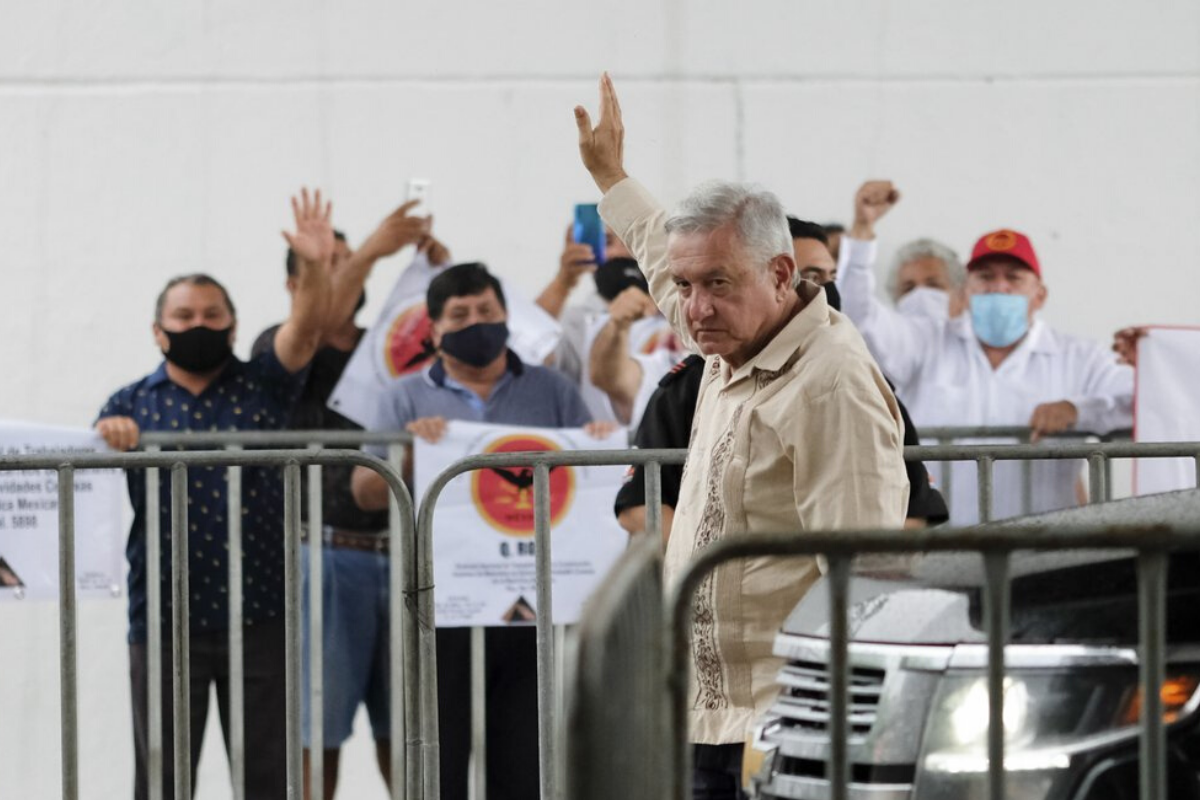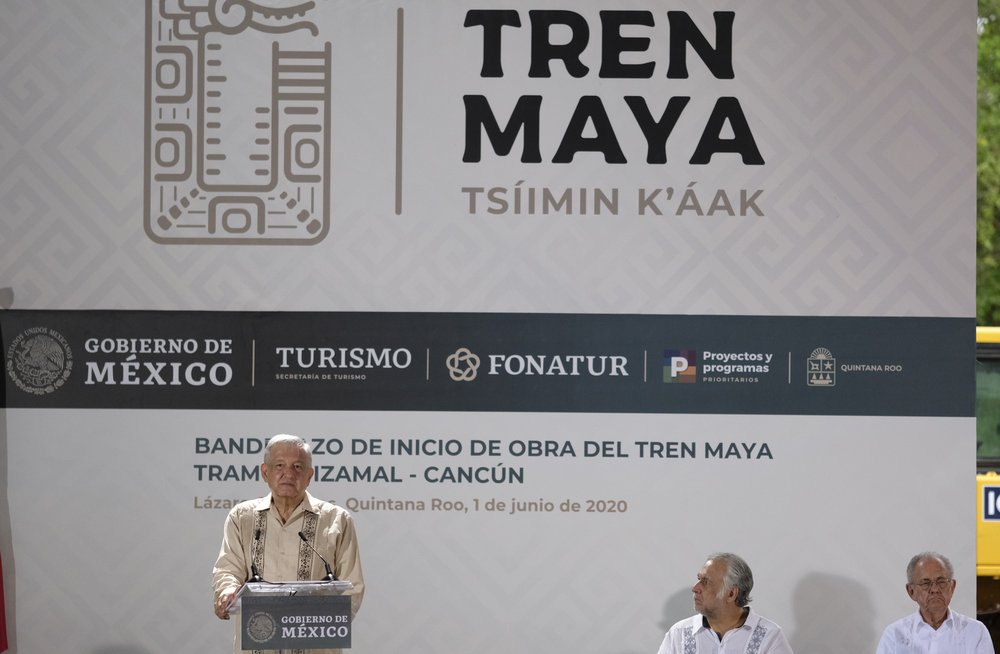

Mexican President Andres Manuel Lopez Obrador waves to supporters in Lázaro Cárdenas, Quintana Roo state, Mexico, Monday, June 1, 2020. (AP Photo/Víctor Ruiz)
By MARÍA VERZA
MEXICO CITY (AP) — Residents of Mexico’s Yucatan Peninsula remember riding trains to visit relatives or sell their produce decades ago, so when President Andrés Manuel López Obrador made a nostalgic pitch to build a “Mayan train” through the region’s jungles the mainly indigenous residents were initially receptive to the idea.
Two years later, as the president inaugurates a leg of the project’s construction Wednesday, that initial enthusiasm has dissipated for a project that would run through five southern states carrying tourists from the resorts of Cancún and Playa del Carmen to the Mayan ruins at Palenque. Many communities in the train’s path feel deceived by scarce information, while activists fear the social and environmental impacts.
But López Obrador remains laser focused on completing one of his signature projects despite the legal challenges and even a pandemic that has killed more than 10,000 Mexicans. If anything, the pandemic has made the project more urgent in the president’s mind.
López Obrador says it will create 80,000 jobs at a time that nearly a million have been lost to the lockdown caused by the novel coronavirus. The train would run some 950 miles (about 1,500 kilometers) from Caribbean beaches to the peninsula’s interior while stimulating economic development around its 15 stations. The government says it will cost as much as $6.8 billion, but others say it will be much more.
López Obrador originally conceived of it as an economic development project to help a long-neglected part of the country. But many locals are beginning to see it differently.
“The train is going to open the heart of the peninsula and bleed it dry little by little,” said Pedro Uc, a member of the assembly of defenders of Mayan Territory Múuch Xiinbal and resident of Buctzotz, a community east of Merida. “There will be [benefits], but in whose pockets?”
Uc said the project will divide communities and bring insecurity. Cancun’s rapid development as a tourist mecca led many away from their communities in search of work only to return years later as crime accelerated.
López Obrador launched the project in early 2019, shortly after taking office. From the start, critics questioned the financial viability of a tourist and cargo train. Even the man in charge of executing the project, tourism development director Rogelio Jiménez Pons, concedes the timeline was accelerated.
“Yes, we’ve skipped some steps, but we are forced to by the circumstances of the political terms,” he said last year, referring to the president’s six-year term.
Since then, the Mayan train has been the cure-all for every challenge. In addition to boosting the southeast’s economic development, López Obrador said it could help solve the region’s migration problems by generating work for Central American migrants. Now, he says it will play a critical part of Mexico’s economic recovery from the pandemic.
Ezer May, an anthropologist and historian from Kimila east of Merida, said initially many people were swept up in the nostalgia for the Mayan train. His own grandparents used to ride the train to Merida. People believed it could bring tourists and higher paying jobs and they trusted López Obrador, who railed against corruption and always spoke of helping the poor.
But as they learned more, they felt the government wasn’t telling the whole story. They worried about developers taking their land for things unrelated to their way of life or needs.
“It’s not about whether we are the minority or the majority, it’s about the threat to our culture, our language, our way of producing,” Uc said.


Amid a pandemic and the remnants of a tropical storm, President López Obrador kicked off Mexico’s return to a “new normal” Monday with his first road trip in two months as the nation began to gradually ease some virus-inspired restrictions. (AP Photo/Victor Ruiz)
The train will run through Mexico’s largest tropical forest, yet few environmental assessments have been made public and those that have warn of significant impacts. The region is full of pre-Hispanic archaeological sites and has a distinctive hydrological system of interconnected subterranean caverns and sinkholes that could be at risk.
“They are forcing us to enter a reality that does not consider our way of life,” Uc said.
The government says otherwise. It touts outreach it has done in these communities that culminated in public consultation in December where more than 90% of those who participated voiced support for the project. However, the United Nations criticized the way the referendum was carried out, noting that only positive information about the project was presented to people. Others pointed to low turnout.
“Very few people went to vote due to disinterest because of the bad information,” said Verónica Rosado, a pastry maker from Izamal, who says she’s not totally opposed to the project, but doesn’t like the way it’s being carried out.
But by making the inauguration of the project’s construction his first trip in two months while coronavirus infections are peaking, López Obrador has made it clear that more time is not something he is willing to give.
The start of construction “arrives at a good moment,” the president said Tuesday. “It’s needed to reactivate the economy.”
In recent months, a court blocked work from starting on stations next to villages inside the Calakmul biosphere in Campeche state. Communities in Chiapas, another state it would pass through, requested a halt because they fear the coronavirus will spread if work begins, and 300 families in Campeche are fighting in court against evictions.
On Tuesday, more than 240 academics and groups said in a statement that the government “dismissed and disobeyed judicial orders” and recommendations of the National Human Rights Commission to push ahead with the project.
López Obrador denies the train will damage the areas it traverses.
“Some who don’t know the southeast could believe what our opponents maintain, that the train will affect the land, that it is going to affect the environment,” he said. “There is no effect” because it will use existing track.
The pandemic has made it more difficult to organize and protest the government’s plan, said May, the anthropologist.
“People are not focused these days on the train, nor Andrés Manuel’s visit, but rather on having something to eat today, having something to eat tomorrow and not getting infected with the virus,” he said. “I’m afraid to say it but I believe they’re going to build the train and the conflict will come after.”


